TK-421
New member
Welcome! By now most of you know that a blow off valve is a big no no, UNLESS you are running a blow thru MAF setup or have converted to SD (Speed Density). Now I'm not going to delve into how the stock by pass valve works, why it's there, or how MAF based systems work. There are other threads explaining that, and it don't want this to be a repeat.
The Stock BPV is a well made great unit, and most times there is no need to replace it. There are some reasons for replacing it though. You maybe running a larger turbo, running more boost, or you could have an older car, with a valve that has started to become leaky under boost conditions. And now you want to replace it, regardless of your reasons you've decided that your stock bpv has got to go.
Now, there are many many many options on the market today. There are your 100% VTA or (Vent to Atmoshpere)', a 50/50 "hybrid" valve, which recirculates 50% of the air back into the intake system to keep the MAF happy, and the other 50% is vented giving that pssssh or whoosh sound. Some of these hybrid valves are 100% adjustable. Like the GFB Respons Valve which can be adjusted to recirculate 100%, 50/50 or vent 100% and anywhere in between. Now finally there are valves that are 100% recirculating just like the stock bypass valve.
Now you might be saying, what is the point of spending money on another valve that does the same thing my stock one does? Almost all aftermarket valves, whether VTA, Hybrid or Recirculating, have the ability to be adjusted where the stock piece can't.
After reading reviews countless times, I decided to give the Forge Recirculation Valve a try. It seems to be a very popular piece with not only STi's but also MazdaSpeed 3's. Let's not forget to mention that the Forge brand is HUGE with Volkswagen, Audi, Porsche and other Euro Cars. It seems to be a very simple unit, yet has the ability to be adjusted to fit your specific application of boost pressure levels.
So I headed on over to www.importimageracing.com and picked up a Forge Recirculating Valve for the 04 to 14 STi. Josh has been taking care of my needs for parts for a decent while now, and on top of that they have some really good competitive pricing. Okay enough advertising and plugging.
Down to business!
So fedex drops the package off, I open the box to find the forge unit, in it's own box and my new replacement Grimmspeed TMIC BPV Gasket.
Here is the Forge BPV packaged nicely in a very quality made box.

Open the box up and see that the valve itself is wrapped up in bubble wrap instead of floating around in the box. And oh look another sticker to add to my toolbox. I do not sticker my cars nor will I ever.
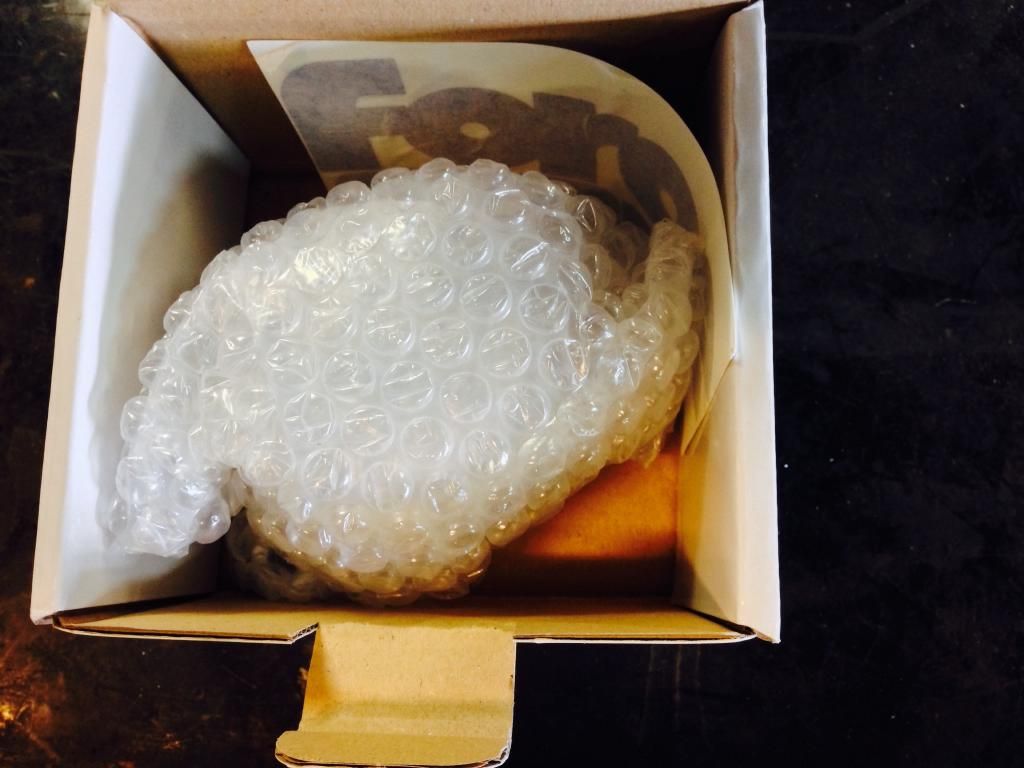
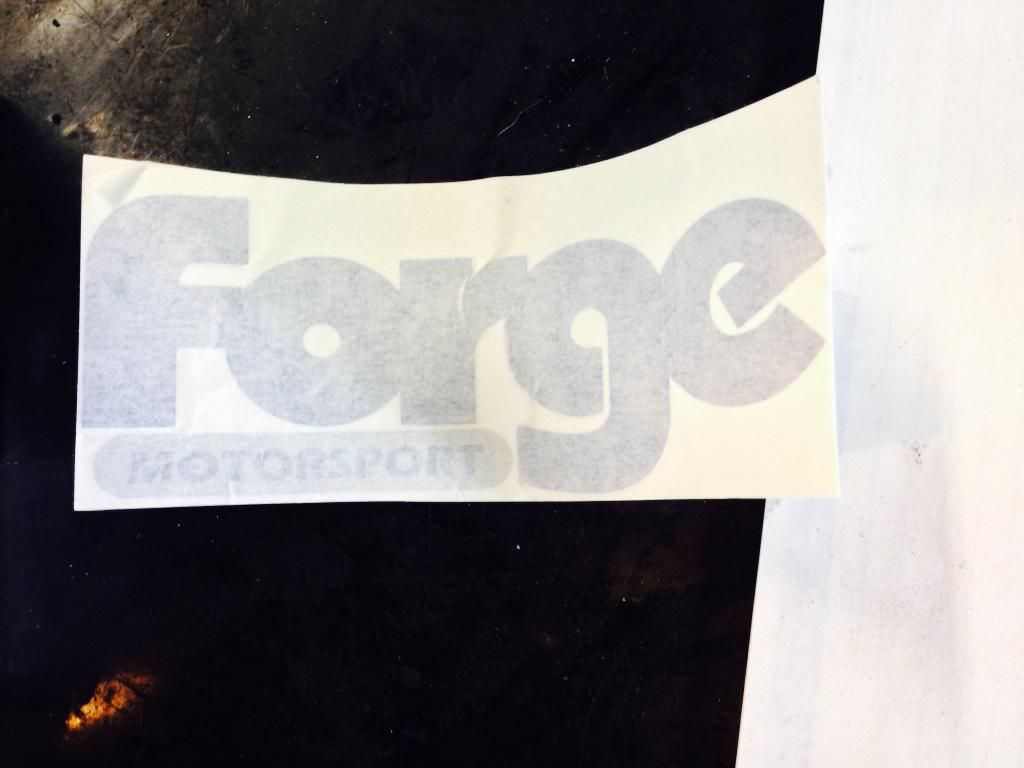
So let's go over the tools you will need to accomplish this task. Now some of you may not do this for a living like I do, so you may not have all the tools that I have. Which is why I will try to do this write up using as many basic hand tools as I can.
Alright the list of tools your going to need at the minimum is as follows:
1/4, 3/8, or 1/2 drive ratchet (I chose a 3/8 ratchet)
A 12mm short or deep well socket, does not matter.
Either a 3 inch, 6 inch or 12 inch socket extension. ( I chose a 12 inch extension out of habit) but I do recommend a extension of some sorts to make life on your knuckles a little easier.
A pair of needle nose pliers, a standard set will work, but if you have a pair of long handle 45 degree pliers use those, as they work the best for the clamp on the recirculation hose.
A Phillips head screwdriver, to remove to 2 screws that secure the elbow piece to the stock BPV.
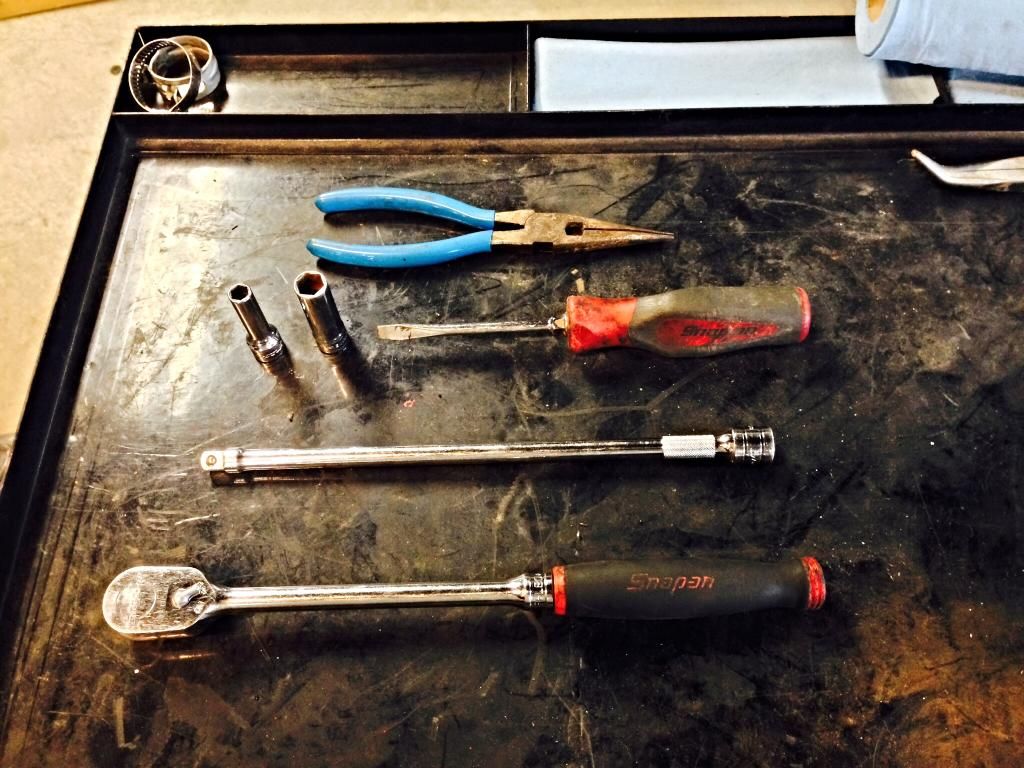
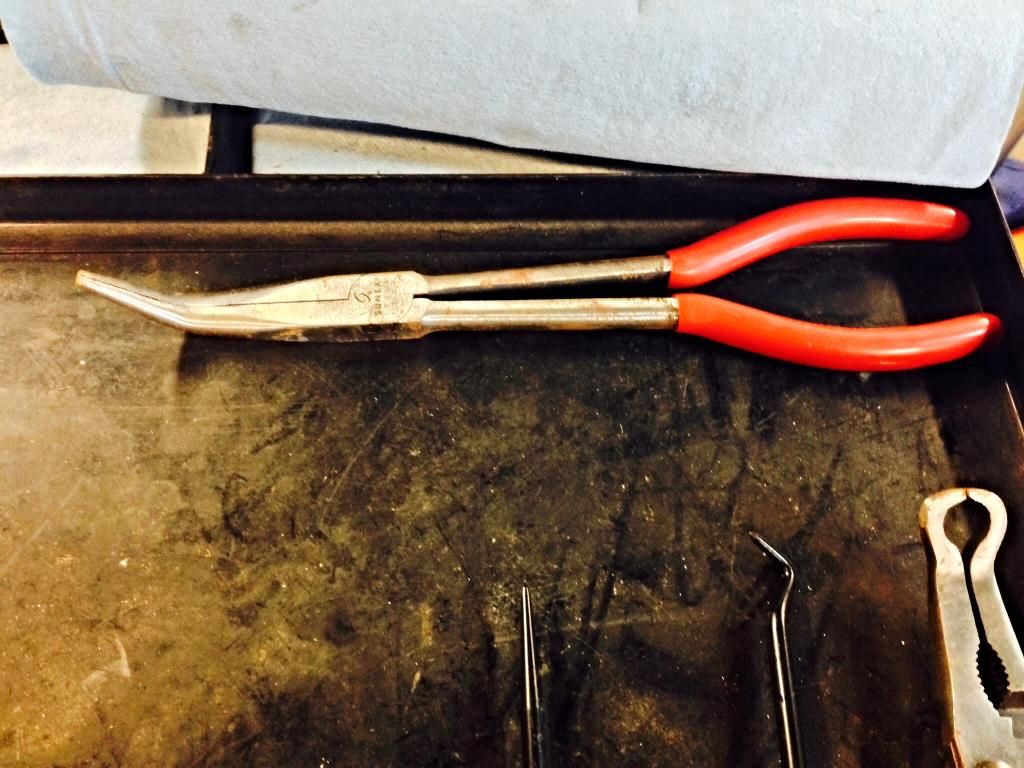
Optional tools are:
A straight hose pick
An Angled hose pick
A Flat Head Screwdriver
A pair of hose gripper pliers
And either a 8mm or 5/16 socket to remove the worm drive hose clamp on your recirculation hose (If you have replaced your stock clamp like I have)
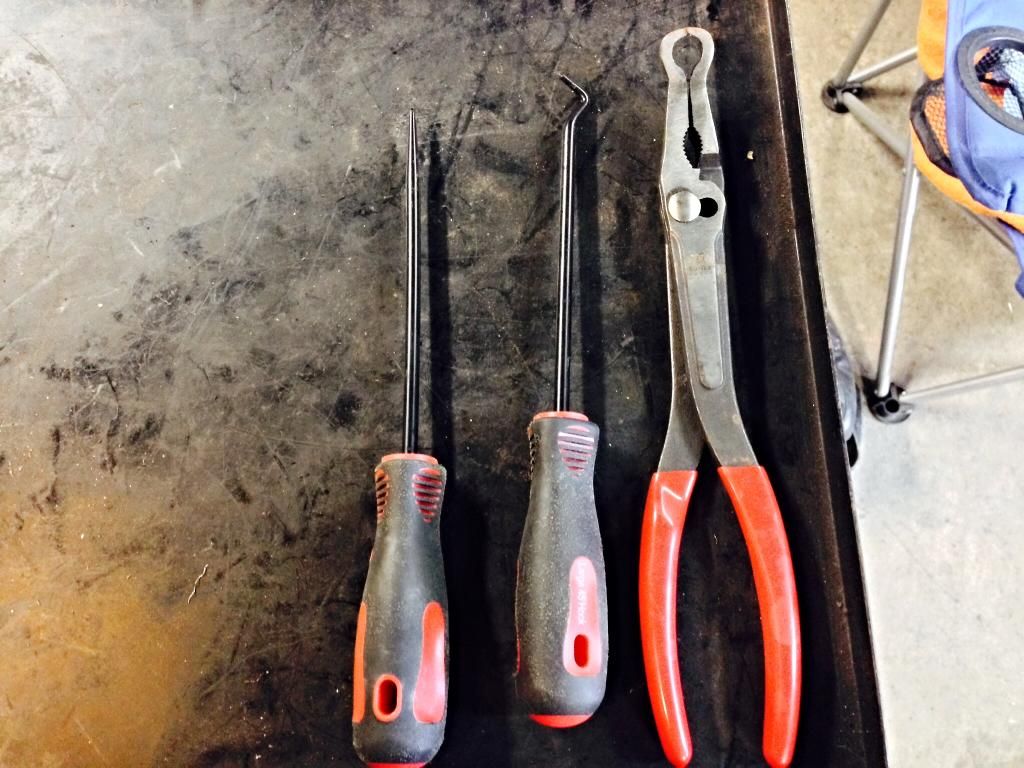
Alright let's get the stock valve off already!
Start with the hose clamp that is on the recirculation hose. While the BPV is still bolted to the intercooler, it makes the job a little easier instead of the BPV flopping around all over the place. I loosened the clamp using my 8mm socket, then continued to back the clamp off with my flathead screwdriver until I could wiggle with my fingers.

Now let's disconnect the vacuum line attached to the fitting on the valve, some pull right off while others tend to stick. If yours is a little stuck on that's okay. Simply take your needle nose pliers and gentle grab the vacuum line, squeeze and apply minimal pressure and work the hose up and down (towards the intercooler and back towards you). Your only using the pliers to break loose the vac line from the fitting so you can pull the line off with your hands. They make a special tool for this, which is why I mentioned hose gripper pliers above. They are special pliers that grip the hose in a fashion to allow you to do just this, without damaging the hose or the fitting it's attached to. If your reading this and you have a wrx with the plastic bpv you'll understand why, as the plastic barb fittings often break when trying to remove stubborn hoses.
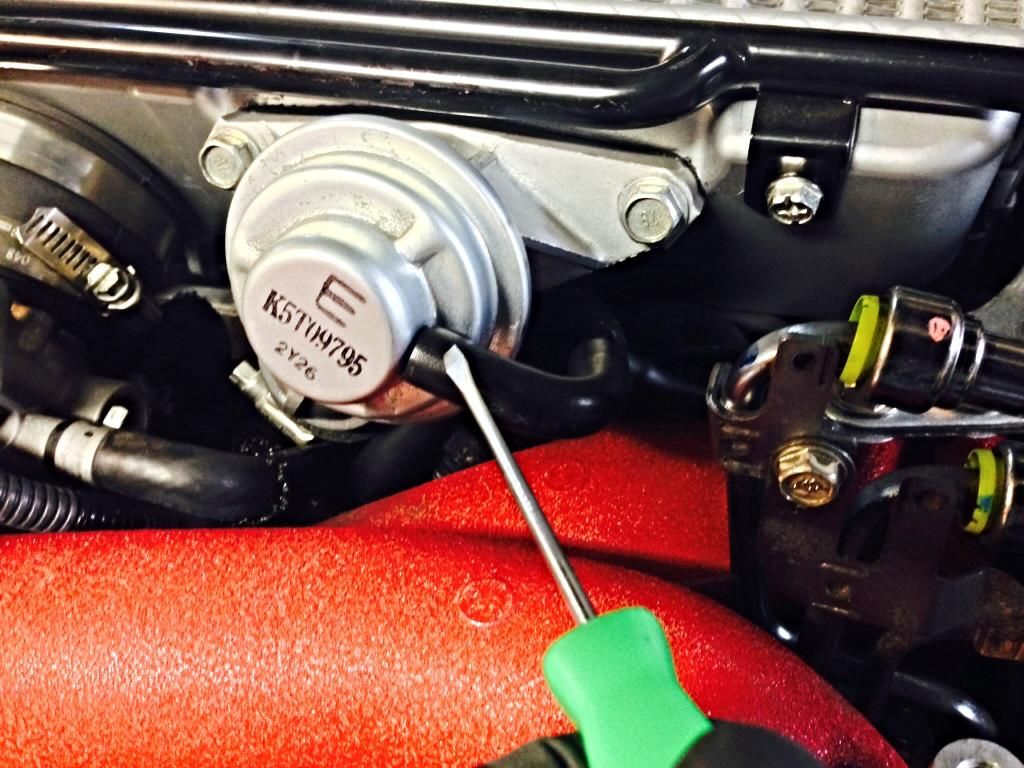
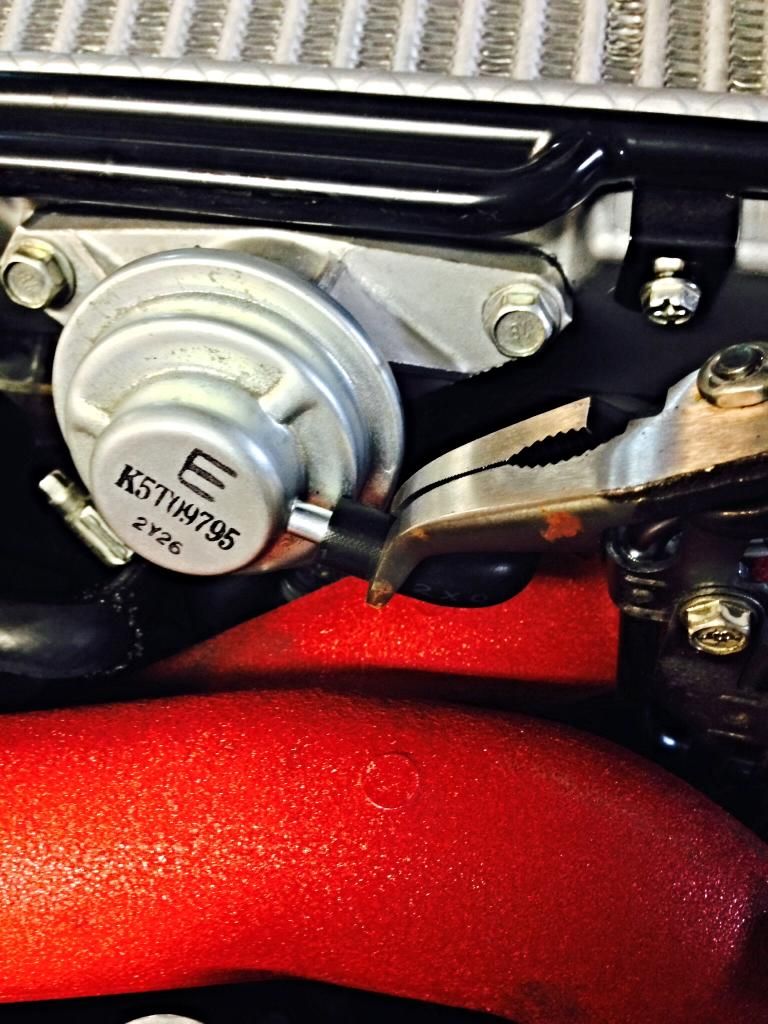
Now that the vacuum line has been disconnected, loosen the two 12mm bolts securing the BPV to the intercooler. Depending on how old the car is, these bolts maybe a little troublesome to remove. Which is why I recommend a long handle ratchet and the use of a 6 point socket. Using a 12 point socket give you a greater chance of rounding the head of the fastener your trying to remove. Crack both bolts loose and remove them and set them aside as you will need them for installation of your Forge unit. There is a gasket behind the BPV sometimes it may stick to the back side of the BPV or the intercooler, that's okay, just leave it there for now.
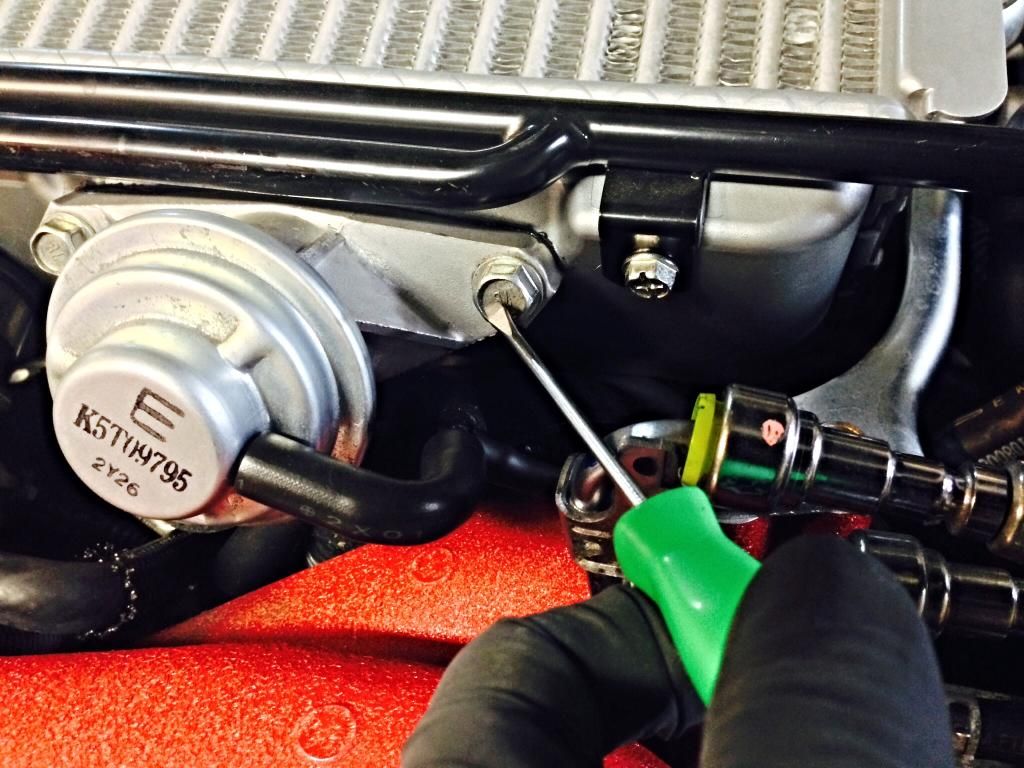

Now this is what most people consider the frustrating part, removing the BPV from the recirculation hose. Here is where that pick comes into play. If you done have a pick, you can use a small pocket Phillips or small pocket flathead screwdriver to accomplish this. Stick the pick/screwdriver in between the hose and the recirculation fitting, and work your way around the fitting trying to loosen the seal between the fitting and the hose. I would recommend going around 2 to 3 times for good measure. After you have done that, the BPV basically comes right out with a slight tug. Now that you have the stock BPV out of the car, take it over to your work bench, or wherever you have your new Forge valve sitting at.
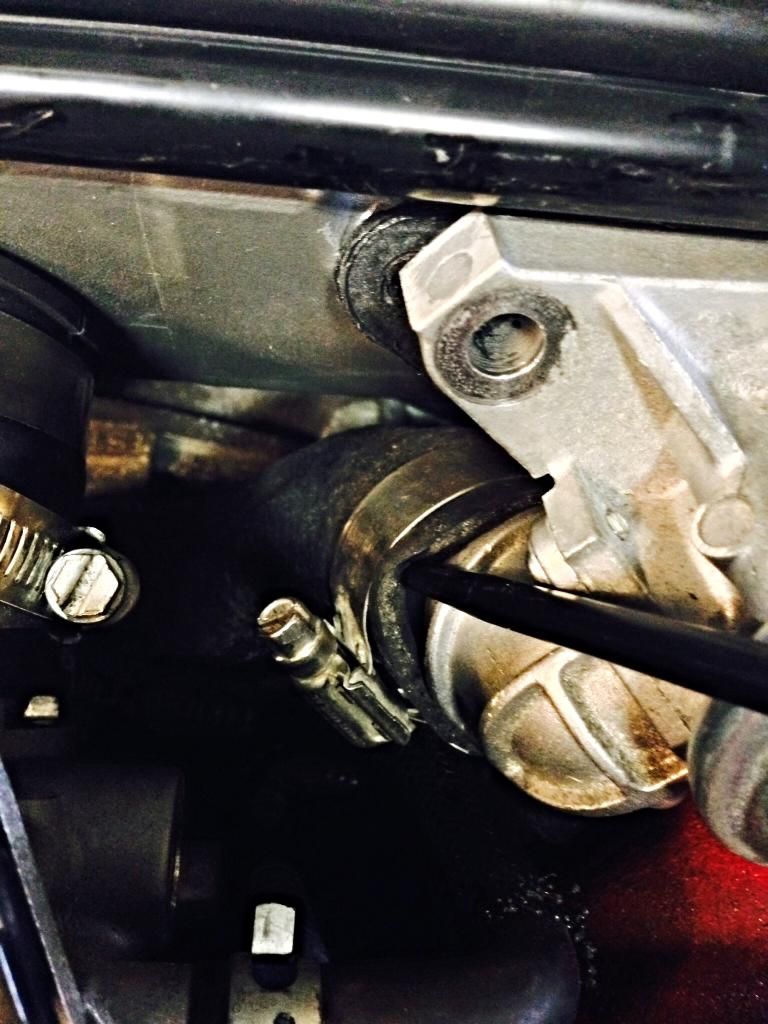

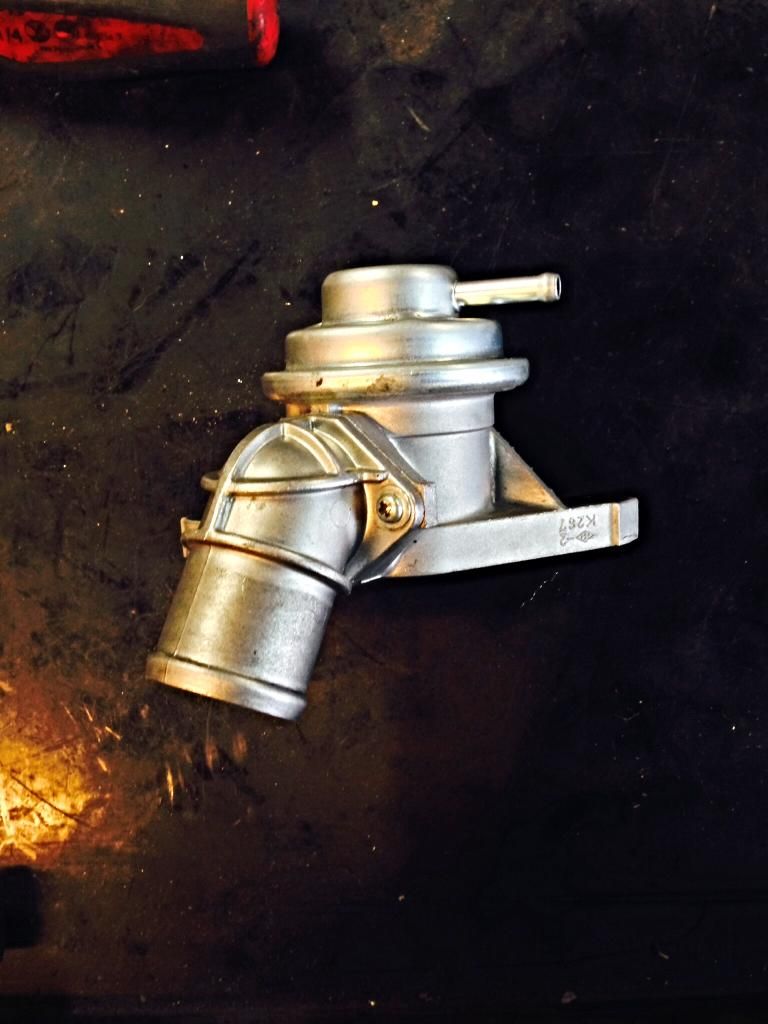
Now this part can also be a bit tricky, you have to remove the stock elbow piece that goes from the valve and into the recirculation hose by way of removing the 2 Phillips head screws. Sounds easy remove two screws right? Wrong! These screws are a PITA. Using your screwdriver you have to simultaneously apply pressure downwards and while trying to twist the screws out, or you will round the heads off these screws. I found using my Ingersoll Rand cordless screw gun to be the only way of removing them, a cordless drill will also net the same results. It seems that these screws have a form of threadlocker put on them from the factory.
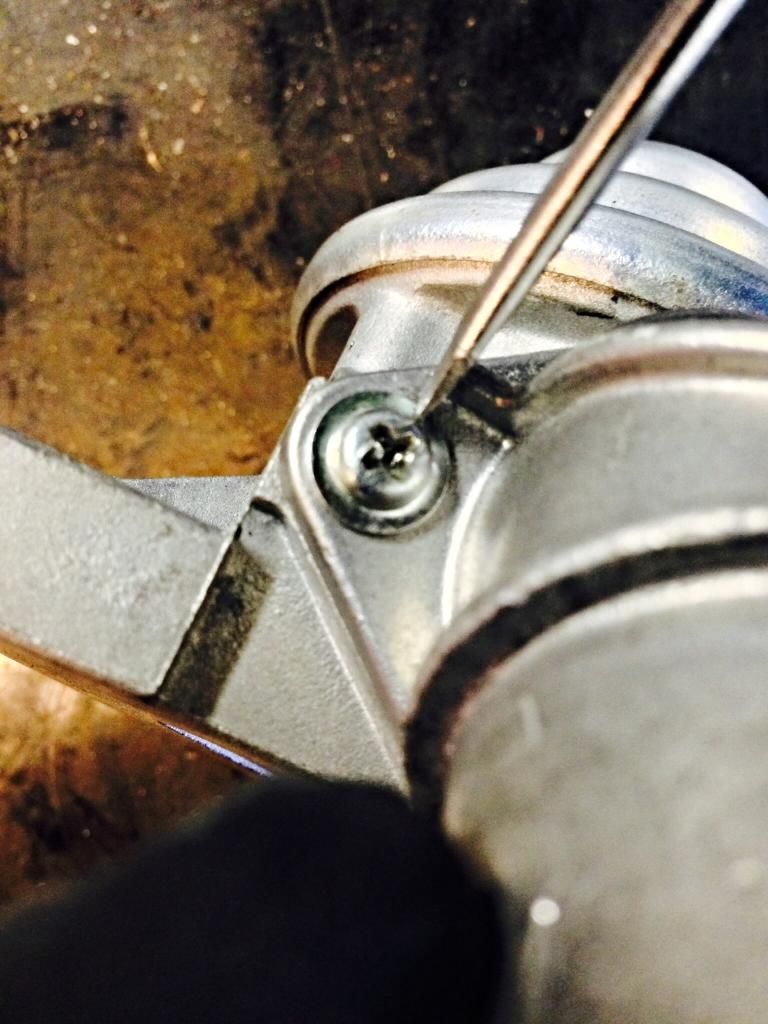
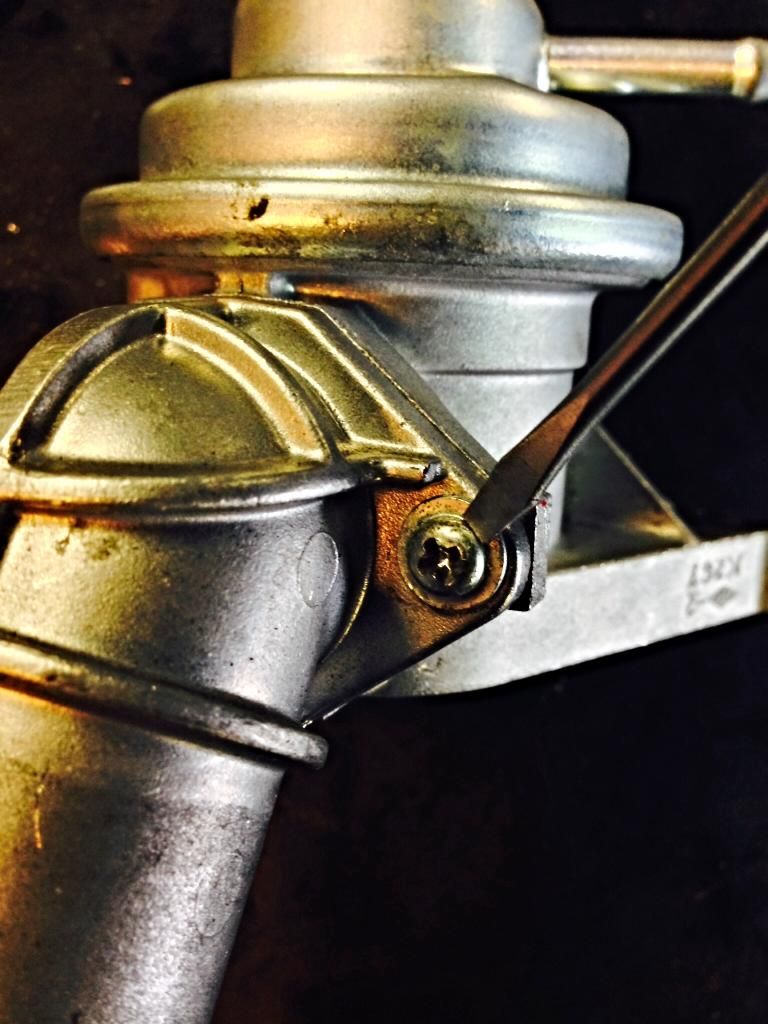
Now that you have removed the two screws, remove the elbow piece, it has a rubber o-ring on the back side, try not to damage this o-ring. Now for good measure I like to take a very small amount of 3M silicone paste and apply it to the o-ring so it doesn't get pinched when you install the elbow on the new valve. DO NOT use regular grease! Regular grease is a petroleum based substance and will eat through the rubber o-ring. If you do not have any silicone paste, just leave the o-ring as it is, but be careful to NOT pinch it when installing it on the Forge unit.
Install the elbow on to the forge unit, tighten down the screws, you don't have to hulk them on, just make sure the elbow is flush and tight against the valve body. Now your ready to head back over to your car.
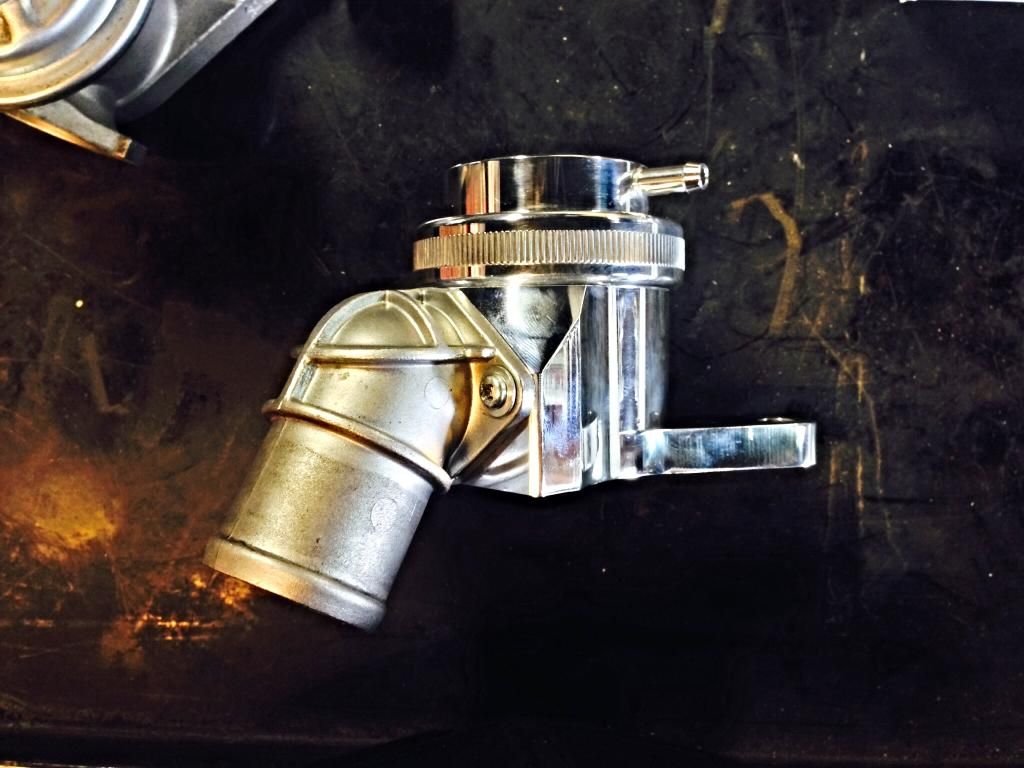
Remember that gasket? Sure you can probably reuse that gasket, but I always replace gaskets when something is being replaced, if I was just putting my stock BPV back on, I'd more than likely reuse the gasket that's already there. But I'm not, so let's get that old gasket off. There seems to be a few small dabs of glue holding the gasket in place on the intercooler, the gasket should peel right off. Now that you have the old gasket off, take a little bit of that silicone paste and apply a small amount to the bottom portion of the recirculation elbow. It will make reinstallation into the recirculation hose much easier. BUT remember silicone based lubricants, as the recirc hose is rubber! Holding the hose in place with either your fingers or pliers insert the valve by pushing and twisting till it can't go any further. Take your clamp and put it back into the same position it was in when you took it off, if using a worm drive clamp like me, tighten down the clamp enough to hold it in place, as we will return to tighten it down fully later on.
Take your new gasket and both of your 12 mm bolts, insert the bolts though the holes of the valve and apply the gasket to the mating surface of the valve, using the bolts to help hold the gasket in place. Start both bolts by hand. You may need to wiggle the valve back and forth and up and down while threading in the bolts to the intercooler. Once you have hand tightened the bolts all the way into the intercooler you may snug them up with your ratchet. DO NOT use impact tools to tighten them up, as the intercooler is aluminum and you can easily strip out the threads from over tightening. If your using a torque wrench like I am the specs for these two bolts are 11.8 ft lbs of torque, I just rounded it up to 12 ft lbs.
Reattach the vacuum line to the barbed fitting on the new valve. Tighten up the hose clamp on the recirculation hose if it's a worm drive clamp like mine. Once again you don't have to he-man it on there, just sung it up. Now start the car, chech for leaks, or any changes in idle or vacuum level on your boost gauge/AccessPORT.
Clean up your tools, put your stock bypass valve in the box the forge unit came in and go for a test drive.
The forge unit should act just as the stock valve would, it should even sound the same, but do not be surprised if you hear a "Ching" like metal clashing noise, some users have reported that, apparently that's normal, but I have yet to experience that. I also purchased the Spring Kit "FMDVTUN" which comes with 4 different springs and 2 shims. My Forge BPV came with a blue colored spring preinstalled. I noticed a small amount of compressor surge at very very low boost levels, so I switched out the blue spring by unscrewing the top of the valve and installing the yellow spring, all while the valve is still on the car, very convenient and nice! The spring kit also came with a green spring, a red spring, another blue spring, and two shims. Right now I'm using the yellow spring and 1 shim and it seems to work quite well for me. No flutter, no surge, and no leaks. All in all very happy with my purchase, and the ease of installation and the ease of changing out the springs. The quality of the valve itself is really nice, polished and thick sturdy flange make it seem like it will be a very durable piece. Once again I would like to thank Josh Nahm at Import Image Racing for the awesome deal, and amazing customer service. He had a tracking number sent to me not even 20 mins after I placed my order! The Forge BPV is in my opinion the best bang for your buck aftermarket BPV you can buy for your Subaru.
I hope this how to install/review helps anyone who is looking to install a aftermarket BPV, particularly the Forge Valve.
As I continue to modify my Subaru, I will continue to do detailed write ups like this to help my fellow enthusiasts with their own projects. As I am a Automotive Technician by trade, I do most of my work by the book and right the first time around. If anyone needs help or advice, do not hesitate to ask, I will do my best to help when and where I can.
Thank you for taking the time to read my how to guide, and review.
Happy modding to you all, TK-421
The Stock BPV is a well made great unit, and most times there is no need to replace it. There are some reasons for replacing it though. You maybe running a larger turbo, running more boost, or you could have an older car, with a valve that has started to become leaky under boost conditions. And now you want to replace it, regardless of your reasons you've decided that your stock bpv has got to go.
Now, there are many many many options on the market today. There are your 100% VTA or (Vent to Atmoshpere)', a 50/50 "hybrid" valve, which recirculates 50% of the air back into the intake system to keep the MAF happy, and the other 50% is vented giving that pssssh or whoosh sound. Some of these hybrid valves are 100% adjustable. Like the GFB Respons Valve which can be adjusted to recirculate 100%, 50/50 or vent 100% and anywhere in between. Now finally there are valves that are 100% recirculating just like the stock bypass valve.
Now you might be saying, what is the point of spending money on another valve that does the same thing my stock one does? Almost all aftermarket valves, whether VTA, Hybrid or Recirculating, have the ability to be adjusted where the stock piece can't.
After reading reviews countless times, I decided to give the Forge Recirculation Valve a try. It seems to be a very popular piece with not only STi's but also MazdaSpeed 3's. Let's not forget to mention that the Forge brand is HUGE with Volkswagen, Audi, Porsche and other Euro Cars. It seems to be a very simple unit, yet has the ability to be adjusted to fit your specific application of boost pressure levels.
So I headed on over to www.importimageracing.com and picked up a Forge Recirculating Valve for the 04 to 14 STi. Josh has been taking care of my needs for parts for a decent while now, and on top of that they have some really good competitive pricing. Okay enough advertising and plugging.
Down to business!
So fedex drops the package off, I open the box to find the forge unit, in it's own box and my new replacement Grimmspeed TMIC BPV Gasket.
Here is the Forge BPV packaged nicely in a very quality made box.

Open the box up and see that the valve itself is wrapped up in bubble wrap instead of floating around in the box. And oh look another sticker to add to my toolbox. I do not sticker my cars nor will I ever.


So let's go over the tools you will need to accomplish this task. Now some of you may not do this for a living like I do, so you may not have all the tools that I have. Which is why I will try to do this write up using as many basic hand tools as I can.
Alright the list of tools your going to need at the minimum is as follows:
1/4, 3/8, or 1/2 drive ratchet (I chose a 3/8 ratchet)
A 12mm short or deep well socket, does not matter.
Either a 3 inch, 6 inch or 12 inch socket extension. ( I chose a 12 inch extension out of habit) but I do recommend a extension of some sorts to make life on your knuckles a little easier.
A pair of needle nose pliers, a standard set will work, but if you have a pair of long handle 45 degree pliers use those, as they work the best for the clamp on the recirculation hose.
A Phillips head screwdriver, to remove to 2 screws that secure the elbow piece to the stock BPV.


Optional tools are:
A straight hose pick
An Angled hose pick
A Flat Head Screwdriver
A pair of hose gripper pliers
And either a 8mm or 5/16 socket to remove the worm drive hose clamp on your recirculation hose (If you have replaced your stock clamp like I have)

Alright let's get the stock valve off already!
Start with the hose clamp that is on the recirculation hose. While the BPV is still bolted to the intercooler, it makes the job a little easier instead of the BPV flopping around all over the place. I loosened the clamp using my 8mm socket, then continued to back the clamp off with my flathead screwdriver until I could wiggle with my fingers.

Now let's disconnect the vacuum line attached to the fitting on the valve, some pull right off while others tend to stick. If yours is a little stuck on that's okay. Simply take your needle nose pliers and gentle grab the vacuum line, squeeze and apply minimal pressure and work the hose up and down (towards the intercooler and back towards you). Your only using the pliers to break loose the vac line from the fitting so you can pull the line off with your hands. They make a special tool for this, which is why I mentioned hose gripper pliers above. They are special pliers that grip the hose in a fashion to allow you to do just this, without damaging the hose or the fitting it's attached to. If your reading this and you have a wrx with the plastic bpv you'll understand why, as the plastic barb fittings often break when trying to remove stubborn hoses.


Now that the vacuum line has been disconnected, loosen the two 12mm bolts securing the BPV to the intercooler. Depending on how old the car is, these bolts maybe a little troublesome to remove. Which is why I recommend a long handle ratchet and the use of a 6 point socket. Using a 12 point socket give you a greater chance of rounding the head of the fastener your trying to remove. Crack both bolts loose and remove them and set them aside as you will need them for installation of your Forge unit. There is a gasket behind the BPV sometimes it may stick to the back side of the BPV or the intercooler, that's okay, just leave it there for now.


Now this is what most people consider the frustrating part, removing the BPV from the recirculation hose. Here is where that pick comes into play. If you done have a pick, you can use a small pocket Phillips or small pocket flathead screwdriver to accomplish this. Stick the pick/screwdriver in between the hose and the recirculation fitting, and work your way around the fitting trying to loosen the seal between the fitting and the hose. I would recommend going around 2 to 3 times for good measure. After you have done that, the BPV basically comes right out with a slight tug. Now that you have the stock BPV out of the car, take it over to your work bench, or wherever you have your new Forge valve sitting at.



Now this part can also be a bit tricky, you have to remove the stock elbow piece that goes from the valve and into the recirculation hose by way of removing the 2 Phillips head screws. Sounds easy remove two screws right? Wrong! These screws are a PITA. Using your screwdriver you have to simultaneously apply pressure downwards and while trying to twist the screws out, or you will round the heads off these screws. I found using my Ingersoll Rand cordless screw gun to be the only way of removing them, a cordless drill will also net the same results. It seems that these screws have a form of threadlocker put on them from the factory.


Now that you have removed the two screws, remove the elbow piece, it has a rubber o-ring on the back side, try not to damage this o-ring. Now for good measure I like to take a very small amount of 3M silicone paste and apply it to the o-ring so it doesn't get pinched when you install the elbow on the new valve. DO NOT use regular grease! Regular grease is a petroleum based substance and will eat through the rubber o-ring. If you do not have any silicone paste, just leave the o-ring as it is, but be careful to NOT pinch it when installing it on the Forge unit.
Install the elbow on to the forge unit, tighten down the screws, you don't have to hulk them on, just make sure the elbow is flush and tight against the valve body. Now your ready to head back over to your car.

Remember that gasket? Sure you can probably reuse that gasket, but I always replace gaskets when something is being replaced, if I was just putting my stock BPV back on, I'd more than likely reuse the gasket that's already there. But I'm not, so let's get that old gasket off. There seems to be a few small dabs of glue holding the gasket in place on the intercooler, the gasket should peel right off. Now that you have the old gasket off, take a little bit of that silicone paste and apply a small amount to the bottom portion of the recirculation elbow. It will make reinstallation into the recirculation hose much easier. BUT remember silicone based lubricants, as the recirc hose is rubber! Holding the hose in place with either your fingers or pliers insert the valve by pushing and twisting till it can't go any further. Take your clamp and put it back into the same position it was in when you took it off, if using a worm drive clamp like me, tighten down the clamp enough to hold it in place, as we will return to tighten it down fully later on.
Take your new gasket and both of your 12 mm bolts, insert the bolts though the holes of the valve and apply the gasket to the mating surface of the valve, using the bolts to help hold the gasket in place. Start both bolts by hand. You may need to wiggle the valve back and forth and up and down while threading in the bolts to the intercooler. Once you have hand tightened the bolts all the way into the intercooler you may snug them up with your ratchet. DO NOT use impact tools to tighten them up, as the intercooler is aluminum and you can easily strip out the threads from over tightening. If your using a torque wrench like I am the specs for these two bolts are 11.8 ft lbs of torque, I just rounded it up to 12 ft lbs.
Reattach the vacuum line to the barbed fitting on the new valve. Tighten up the hose clamp on the recirculation hose if it's a worm drive clamp like mine. Once again you don't have to he-man it on there, just sung it up. Now start the car, chech for leaks, or any changes in idle or vacuum level on your boost gauge/AccessPORT.
Clean up your tools, put your stock bypass valve in the box the forge unit came in and go for a test drive.
The forge unit should act just as the stock valve would, it should even sound the same, but do not be surprised if you hear a "Ching" like metal clashing noise, some users have reported that, apparently that's normal, but I have yet to experience that. I also purchased the Spring Kit "FMDVTUN" which comes with 4 different springs and 2 shims. My Forge BPV came with a blue colored spring preinstalled. I noticed a small amount of compressor surge at very very low boost levels, so I switched out the blue spring by unscrewing the top of the valve and installing the yellow spring, all while the valve is still on the car, very convenient and nice! The spring kit also came with a green spring, a red spring, another blue spring, and two shims. Right now I'm using the yellow spring and 1 shim and it seems to work quite well for me. No flutter, no surge, and no leaks. All in all very happy with my purchase, and the ease of installation and the ease of changing out the springs. The quality of the valve itself is really nice, polished and thick sturdy flange make it seem like it will be a very durable piece. Once again I would like to thank Josh Nahm at Import Image Racing for the awesome deal, and amazing customer service. He had a tracking number sent to me not even 20 mins after I placed my order! The Forge BPV is in my opinion the best bang for your buck aftermarket BPV you can buy for your Subaru.
I hope this how to install/review helps anyone who is looking to install a aftermarket BPV, particularly the Forge Valve.
As I continue to modify my Subaru, I will continue to do detailed write ups like this to help my fellow enthusiasts with their own projects. As I am a Automotive Technician by trade, I do most of my work by the book and right the first time around. If anyone needs help or advice, do not hesitate to ask, I will do my best to help when and where I can.
Thank you for taking the time to read my how to guide, and review.
Happy modding to you all, TK-421


